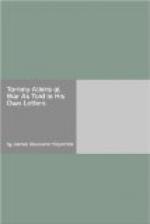That the nervous strain of aerial warfare is severe is shown by expression in several airmen’s letters. Not only have they to fight their man, but they have to manage their machines at the same time. This means that if an airman ascends alone he is unable to use a rifle and must depend for attack on revolver fire only. This is illustrated by a passage in one of the official reports: “Unfortunately one of our aviators, who has been particularly active in annoying the enemy by dropping bombs, was wounded in a duel in the air. Being alone on a single-seated monoplane, he was not able to use a rifle, and whilst circling above a German two-seater in an endeavor to get within pistol shot was hit by the observer of the latter, who was armed with a rifle. He managed to fly back over our lines, and by great good luck descended close to a motor ambulance, which at once conveyed him to hospital.”
This appears to be only the second instance recorded during the first two months of the war in which our airmen have suffered mishap, yet half-a-dozen German machines have been brought down and their navigators either killed or wounded. Private Harman, King’s Royal Rifles, describes an exciting pursuit in which a German aeroplane was captured. The British aviator, who had the advantage in speed and was a good revolver shot, evidently greatly distressed the fugitive, for, surrendered, he planed down in good order, and on landing was found to be dead.
According to an officer in the Royal Flying Corps the worst aerial experience in war is to go up as a passenger. “It is ‘loathly,’” he says, “to sit still helplessly and be fired at.” In one flight as a spectator his machine was “shelled and shot at about a hundred times, but luckily only thirteen shots went through the planes and neither of us was hit.” An interesting account of a battle seen from the clouds is given in a letter published by The Times. “I was up with —— for an evening reconnaissance over this huge battle. I bet it will ever be remembered as the biggest in history. It extends from Compiegne right away east to Belfort. Can you imagine such a sight? We flew at 5 p.m. over the line, and at that time the British Army guns (artillery, heavy and field) all opened fire together. We flew at 5,000 feet and saw a sight which I hope it will never be my lot to see again. The woods and hills were literally cut to ribbons all along the south of Laon. It was marvelous watching hundreds of shells bursting below one to right and left for miles, and then to see the Germans replying.”
Another officer of the Flying Corps describes his impression of the Battle of Mons, seen from a height of 5,000 feet. British shells were bursting like little bits of cotton wool over the German batteries. A German attack developed, and the airman likens the enemy’s advance formation to a “large human tadpole”—a long dense column with the head spread out in front.




